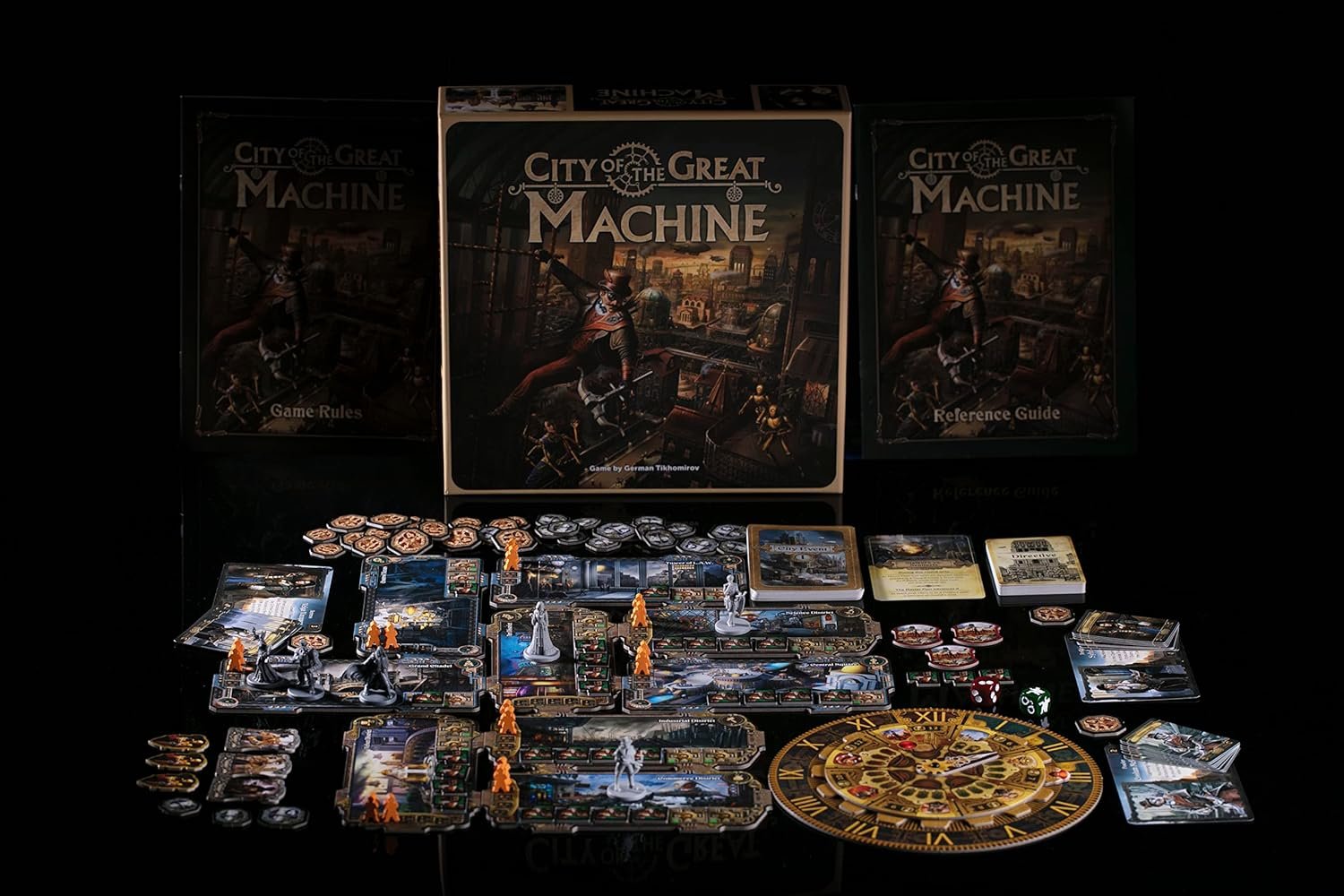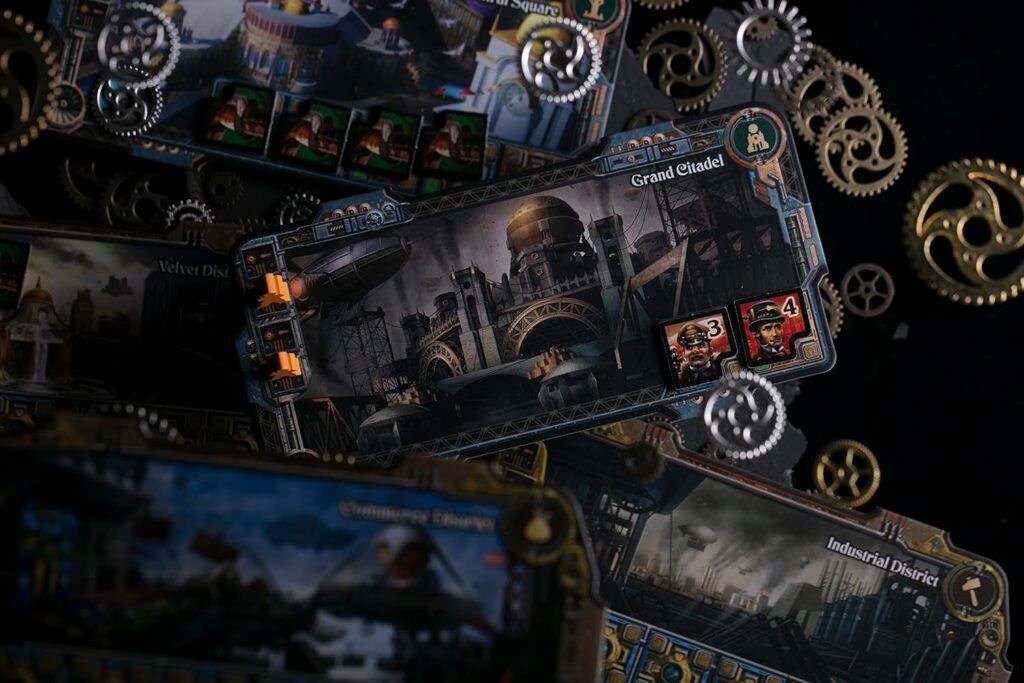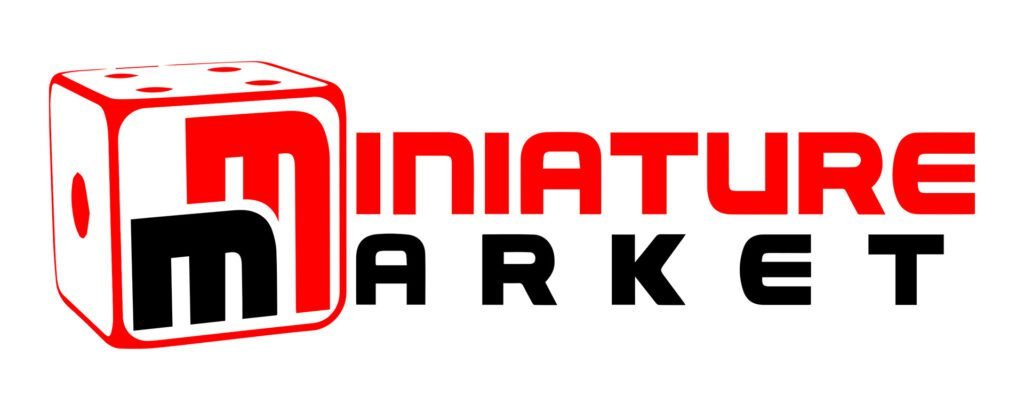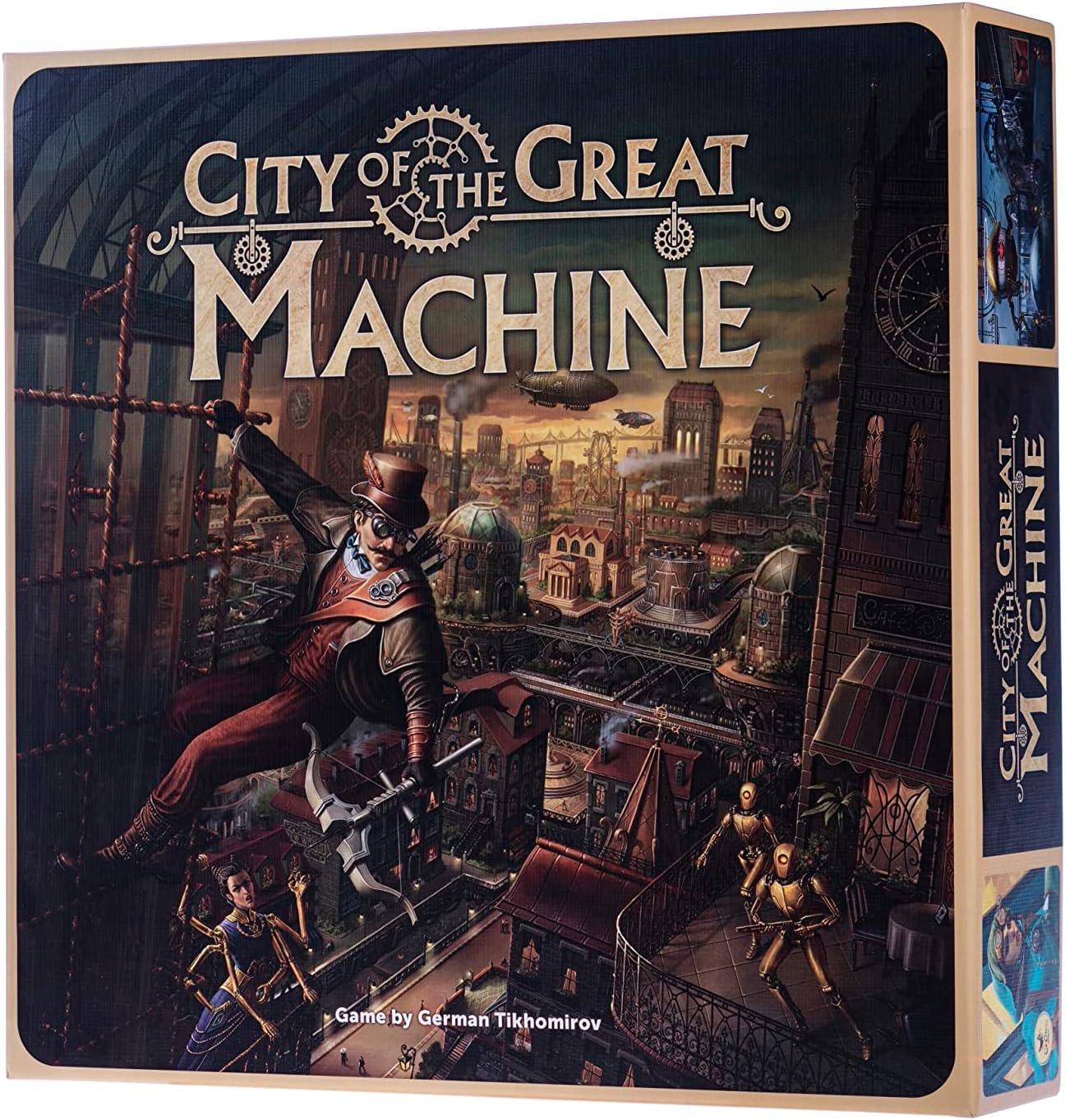
Today, we’re taking a deep dive into the steampunk world of “City of the Great Machine,” designed by German Tikhomirov & published by CrowD games. This game pits an artificial intelligence network against a band of heroes in a Victorian-inspired, technocratic dystopia. So, let’s break it down – what it is, what’s good, what’s bad, & whether you should add it to your collection. Let’s get into it.

What It Is
“City of the Great Machine” is a strategic board game set in a grim, technocratic Victorian steampunk universe. The game features a conflict between the Great Machine, an artificial intelligence network, & an alliance of Heroes. The game supports 1-4 players & can be played in a One-vs-Many format (2-4 players) or cooperatively/solo (1-3 players). The Great Machine can be controlled by a player or automated, changing the gameplay dynamics entirely.
The Great Machine controls a city built on mobile platforms in the sky, commanding perfected Servants & mechanical Guards. Its goal is to suppress social unrest & complete its Master Plan to perfect the human race. The Heroes work together to incite rebellion, gather support from citizens, & prevent the Great Machine from completing its Master Plan, which would lead to human enslavement.
Gameplay Mechanics
The game offers multiple play modes, including solo & cooperative options. Typically, one player controls the Great Machine, its guards, & three servants, while one to three other players manage a team of three Heroes. Each Hero has unique abilities, an initiative number, & a currency called “trust.” The game unfolds through several phases each round, involving strategic planning & various actions on a modular board.
The game board comprises minor & major district tiles, which can be arranged randomly or according to specific maps in the rulebook. Each district starts with two mechanical guards & several unrevealed citizen tiles, representing the city’s population. Citizens can join the rebellion or remain loyal to the Great Machine. Major districts offer special actions for both sides, while minor districts allow Heroes to raise discontent levels. Both sides can manipulate the board by moving district tiles, provided they stay connected to at least two other districts.
Progress is tracked using a multi-layered wheel with two dials. The inner dial measures citizen discontent, activating new citizen groups for the Heroes but increasing the Great Machine’s income. Raising discontent to the top causes a riot, bringing the Heroes closer to victory. The outer dial tracks the Great Machine’s master plan, which, upon reaching twelve, results in an automatic win for the Great Machine.
At the start of each round, a city event card sets two conditions: an ongoing or end-of-round task for one team, & a special condition that advances the Great Machine’s master plan if met. Players then collect income: Heroes gain trust based on their district’s citizens, & the Great Machine gains bonds based on the discontent level.
The access phase is crucial for the Heroes, who decide their moves by playing face-down cards. They collaborate to predict the Great Machine’s actions, but all communication is open, adding a strategic challenge. The Great Machine listens to their plans, forcing the Heroes to use misdirection.
The Great Machine operates through its guards & servants, using bond tokens to move & act. Guards hinder Hero actions & can be strategically placed, while servants arrest citizens, repair guards, perform district actions, & conduct raids. When a Hero ends their turn in a raided district, the Great Machine can advance their master plan or hinder the Hero’s progress by taking their access card or converting trust to bonds. The Great Machine also gains directives that introduce new challenges for the Heroes.
After the Great Machine’s phase, Heroes act in initiative order, moving to their chosen locations & spending trust or rolling dice if necessary. Heroes can attack guards, reveal citizens, raise discontent, & perform special actions like inciting riots or rescuing citizens. Successful riots disable guards, while failed ones lead to citizen arrests & advancement of the master plan.
Once all Heroes have acted, the active city event card is resolved, discontent rises for failed raids, & a new round begins with a fresh City Event. This cycle continues until one of the win conditions is met.
The Solo & Cooperative mode features an AI-controlled Great Machine module, allowing 1-3 players to team up against it. The AI uses an automated deck to control servants, each with prioritized actions in new districts. This mode includes unique events & directives, plus scenarios that offer distinct win conditions & story-driven campaigns. The game also features missions that can be combined for replayability, making it one of the best solo/cooperative modules available.

The Components
The components of “City of the Great Machine” are impressive and thoughtfully designed. Each hero and servant comes with its own detailed miniature, and the color tint helps distinguish between the two player sides easily. The cardboard used throughout the game is thick and high quality, ensuring durability and a satisfying tactile experience.
The artwork on the cards and board is a steampunk enthusiast’s dream, featuring intricate details and rich color palettes that immerse players in the game’s dark, Victorian-inspired world. While the cards themselves are of high quality, the abundance of small cards can be a bit cumbersome. The player access cards, in particular, are small and somewhat difficult to read, which could have been improved with larger cards and more distinct artwork.
One of the standout features of the game is the rulebook and reference guide. The rulebook is well-organized, starting with the setup and providing detailed descriptions of each game phase. Each phase is accompanied by full-color examples and clear explanations of actions, along with some strategies for new players. This sequential layout makes it easy to follow and understand the game mechanics.
The reference guide is equally comprehensive, explaining city events, directives, and hero abilities in depth. It also outlines the solo and cooperative modules with the same level of detail as the main game. Combined with player aid cards, these two books make learning the game straightforward and provide a quick reference during gameplay, enhancing the overall experience

The Good
The theme of “City of the Great Machine” is compelling & well-executed. The Victorian steampunk setting is richly detailed & immersive, drawing players into its unique world. The asymmetric gameplay keeps both sides engaged, as Heroes & the Great Machine have distinct goals & strategies.
The hidden movement & secrecy elements add a layer of tension & excitement. Heroes must outsmart the Great Machine, who is constantly trying to anticipate & counter their moves. This creates a cat-and-mouse dynamic that is both challenging & rewarding.
The modular board provides endless replayability. Each game can have a different city layout, keeping the experience fresh & unpredictable. The ability to reposition City Districts adds a strategic depth that enhances the overall gameplay.
The game also accommodates different player counts well. Whether you’re playing solo, cooperatively, or in a One-vs-Many format, the game scales effectively & maintains its strategic depth.
The Bad
Despite its strengths, “City of the Great Machine” has some potential downsides. The game’s complexity might be a barrier for new players. The combination of hidden movement, resource management, & asymmetric gameplay requires a good understanding of the rules & strategies, which might be overwhelming for some.
The length of the game can also be a consideration. With the strategic depth & numerous actions to manage, sessions can run long, especially with more players. This could make it less appealing for those looking for a quicker, more casual game.
The cooperative & One-vs-Many formats, while flexible, might not appeal to everyone. Some players may prefer a more straightforward competitive game or a purely cooperative experience without the hidden movement & secrecy mechanics.
The Verdict
So, should you buy “City of the Great Machine”? If you’re a fan of strategic, thematic games with a rich, immersive setting, this game is definitely worth considering. The Victorian steampunk theme, combined with the asymmetric gameplay & hidden movement mechanics, offers a unique & engaging experience.
For seasoned board gamers, “City of the Great Machine” provides a deep, strategic challenge with high replayability. The modular board & varied strategies keep the game fresh & exciting each time you play.
However, if you’re new to complex strategy games or prefer simpler mechanics, this might not be the best fit. The learning curve & game length could be daunting, & the asymmetric, hidden movement gameplay might not be to everyone’s taste.

Final Thoughts
“City of the Great Machine” stands out as a top-tier board game in 2023. It’s not just an ordinary game but a profound piece of art that critiques our society’s obsession with artificial intelligence. The game isn’t just about playing—it communicates a sharp commentary on our current predicament through its gameplay. The notion of placing a player in the role of an artificial consciousness, striving to understand & manipulate human thoughts, is both terrifying & brilliant. It forces players to confront the consequences of our technological advancements in a deeply engaging way.
One of the game’s greatest strengths is its incredibly well-crafted rulebook. It’s clear, concise, & easy to understand, which is often a rare find in games of this complexity. Additionally, the solitaire mode is a robust experience on its own, making it a perfect choice for solo players who still want a full & challenging experience. The game’s physical components are also top-notch, making it a beautiful artifact to own & display.
However, it’s worth noting that the game does have a lengthy playtime & can be somewhat fragile if players struggle to grasp the rules or form coherent strategies. This can be a bit of a drawback, but the game includes methods to adjust the difficulty, allowing for a more balanced experience. The requirement of exactly three revolutionary characters, regardless of player count, might be a slight annoyance for some, but it’s a minor issue in the grand scheme of things.
The confrontational nature & the unique hidden movement mechanic might not appeal to everyone. Some may find the steampunk aesthetic unappealing or the gameplay too long. But for me, this game hits the mark. It channels my emotions & allows me to confront & combat the formless threats that feel all too real in today’s world.
The gameplay is intense & engaging from the very first turn. Unlike many hidden movement games that take time to build up tension, every turn in “City of the Great Machine” feels valuable. Playing with a full complement of four players brings energy to the table, though it does slow down decision-making & complicate communication. In contrast, the one-on-one games were some of the most intense & enjoyable experiences I’ve had, allowing for quicker decisions & a more streamlined gameplay.
Despite its occasional reliance on luck, which can lead to swift downturns if guesses go awry, the guessing element adds a layer of excitement & unpredictability that keeps the game thrilling. The necessity to pay attention & make careful observations is crucial, & while luck can sometimes dictate the outcome, it also contributes to the game’s overall excitement & replayability.
Overall, “City of the Great Machine” is a masterpiece of game design & production. It offers a unique & thought-provoking experience that stands out in any board game collection. The combination of deep thematic content, challenging gameplay, & high-quality components make it a game that respects both the player & the consumer. It’s a game that I wholeheartedly recommend for those looking for something truly special.
Purchase Options




At no extra cost to you, The Board Game Site may receive revenue from affiliate and advertising partnerships for sharing this content and from purchases through links.






